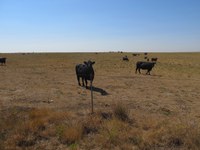Now is Time for Producers to Evaluate Forage Supplies
(Click the image below to view a high-resolution image that can be downloaded)
Livestock producers in many areas of North Dakota are experiencing shortages in forage production due to cooler temperatures and drought, especially in the northern and north-central regions of the state.
“It is important that producers have trigger dates identified for making critical decisions on their operations,” says Miranda Meehan, North Dakota State University Extension livestock environmental stewardship specialist. “In terms of grazing management, July 1 is one of the most important dates for livestock producers in North Dakota. By July 1, 90% of forage has been produced on most range and pasturelands, with the exception being areas dominated by warm-season grasses.
“Now is the time for producers to evaluate available forage and adjust stocking rates,” she adds. “Making early adjustments to the stocking rate will prevent overgrazing and reduce the length of time it takes to recover from drought and improve the long-term sustainability of your operations. Overgrazing can have long-term impacts on the entire rangeland plant community, leading to a loss of forage production, changes in plant species composition, soil erosion, weed growth and a reduction in the soil’s ability to hold water.”
Producers need to make those decisions now because precipitation on cool-season-dominated grasslands will enhance forage quality but will have little impact on production after July 1. Even a surplus of late-season precipitation (July-August) does not increase forage production significantly, according to research conducted at the U.S. Department of Agriculture’s Fort Keogh Livestock and Range Research Laboratory in Miles City, Mont.
Other important dates include Sept. 1 and Nov. 1, notes Kevin Sedivec, NDSU Extension rangeland management specialist. Warm-season grasslands have produced the majority of their forage at this time. In addition, producers will be able to complete an assessment of other forage resources available, including annual forages and harvested feeds. By Nov. 1, producers will have had a chance to inventory pastures and estimate stocking rates for the following spring.
A number of water and forage quality issues can impact animal health during dry conditions.
“It is a good idea to monitor dugouts and ponds for water quality throughout the grazing season, especially with shallow water sources,” Meehan advises. “The incidence of prussic acid, nitrate, mycotoxins and other potential feed toxicities of livestock may increase in crops and annual forages during drought.”
NDSU Extension’s county offices typically offer screening tools for several of these issues, including total dissolved solids (TDS) content in water and a Nitrate QuikTest to determine the presence of nitrates. Extension agents can help producers determine if further analysis is needed.
If forage availability is an issue, producers may need to move cows to pastures not affected by drought or to a drylot. If pastures had normal spring greenup but production is limited, the most limiting nutrient for beef cattle is likely energy. If cows cannot consume sufficient forage on pasture to meet requirements, using high-fiber energy supplements such as alfalfa hay, distillers grains, beet pulp, wheat midds or soy hulls may be possible to replace a portion of forage.
Janna Block, Extension livestock systems specialist at NDSU’s Hettinger Research Extension Center, recommends comparing supplement options on a cost per pound of nutrient basis while taking into account transportation, equipment and feed delivery costs. If forage is brown and dry, protein and energy may be deficient. In this situation, trying to supplement cattle on pasture may be more harmful and expensive in the long run.
“One of the most difficult and emotional decisions that must be made is the need to liquidate or relocate a portion or all of the herd,” Meehan says. “However, making these decisions early can be advantageous, particularly if drought conditions are widespread.”
Pregnancy checking can be done accurately using ultrasound when the fetus is about 35 to 45 days of age, and marketing late calvers or open cows will help shorten the calving season and save on feeding costs.
Other candidates for culling should include cows that lost calves, older cows with decreasing productivity, and cows with bad dispositions or soundness issues. Producers also should evaluate the number of heifers needed for replacements and consider reducing these numbers if necessary.
“It is important to keep in mind that the economic impacts of depopulating the cow herd will extend well beyond the drought year or years,” Block cautions. “Factors such as predicted calf prices, cow replacement costs and costs associated with keeping cows on the ranch should be carefully evaluated.”
Although not an option for everyone, early weaning calves is one of the best ways to reduce nutrient requirements of the cow, resulting in improved cow body condition and pregnancy rates while conserving forage, Block says. Calves have been weaned successfully as early as 2 months of age; however, this may not be practical in all situations.
High-quality rations, appropriate facilities and excellent health programs must be provided for this strategy to be successful. Producers could consider early weaning a portion of the calf crop (calves from first-calf heifers, for example) if weaning the entire herd early is not feasible. Options for early weaned calves include selling them as light feeders, feeding until calves can be sold at the traditional marketing time and weight, or retaining ownership of the calves through finishing.
“Producers need to consider the goals of their ranch and the short- and long-term needs of their families, in addition to their current financial position,” Sedivec says. “It is important to have a thorough understanding of ranch resources to balance rangeland health with livestock production. There is no ‘one size fits all’ plan for drought management.”
NDSU Agriculture Communication - June 26, 2019
| Source: | Miranda Meehan, 701-231-7683, miranda.meehan@ndsu.edu |
|---|---|
| Source: | Kevin Sedivec, 701-424-3606, kevin.sedivec@ndsu.edu |
| Source: | Janna Block, 701-567-4323, janna.block@ndsu.edu |
| Editor: | Ellen Crawford, 701-231-5391, ellen.crawford@ndsu.edu |


